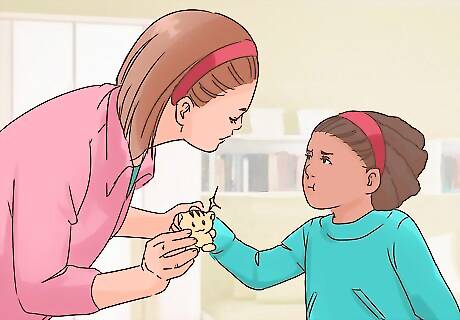
views
Establishing Appropriate Discipline

Establish rules and boundaries. It is important that all children know what rules and boundaries exist within a particular setting, whether it is within the home, at school, or in a social setting. Clearly communicate these rules and expectations for behavior to the child.

Communicate your expectations. Once you establish rules and boundaries, you will want to communicate these to the child. Make sure the child understands the consequences for both good and bad behavior. For example, if the child does not do their homework, you might require them to spend extra time studying on the weekend.

Be consistent. If you want a well-behaved child, you will need to be consistent with both rules and consequences. Once you establish rules, create consequences, and communicate your expectations to the child, you will need to be consistent. For example, if the child frequently refuses to practice orientation skills with their service dog, the consequence should be the same every time.

Help the child learn natural consequences. Natural consequences are experiences that naturally occur after a behavior. For example, if the child breaks a toy, they will no longer be able to play with the toy. By refusing to go out and buy the child a new toy, you are helping them learn natural consequences.

Teach the child logical consequences. Logical consequences are those that you, as a parent or caregiver, set up to logically follow a specific behavior. Describe to your child what the consequences are for unacceptable behavior, and link the consequence directly to the behavior. For example, if the child does not help pick up their toys, then you will take those toys away for a set period of time.

Take away the child’s privileges. If there is not a logical or natural consequence for the child’s behavior, you can take away a privilege as a form of discipline. For example, if the child does not complete their homework on time, you can take away their music privileges for the evening.
Modifying Problematic Behaviors

Identify your child’s challenging behaviors. Think about the child’s behavior and identify those you find challenging. Consider each behavior individually. Think about where and when the behavior occurs, as well as who is involved when it happens.

Think about what is causing the behavior. While you may initially react to a challenging behavior in a number of ways, it is important to take a step back and understand what is causing the behavior. Consider all the factors involved when the behavior occurs and why it might be happening.

Think about why your child is behaving this way. All behavior serves a purpose, and it is important to understand what the function of your child’s behavior is. Your child might behave in a certain way to gain attention, avoid situations or activities, or as a response to a sensory or physical experience.

Avoid stimulating or potentially triggering situations. If you determine an emotional or environmental trigger causes the child’s behavior, you should work to change the child’s environment and remove the triggers. For example, if the extreme cold of the grocery store’s freezer isle causes your child to have a sensory reaction and subsequent meltdown, try avoiding that environment when shopping with the child.

Correct attention-seeking behaviors. You can help your child modify these behaviors by increasing the positive attention your regularly give them, ignoring inappropriate behavior used to get attention, and working with the child to find ways to ask for what they want in a more appropriate manner.

Teach the child a replacement behavior. Once you figure out the root of the child’s behavior and whether or not there are emotional and environmental triggers involved, you can work on teaching the child a new behavior. This new behavior can replace the old one.

Seek professional help. If your child is engaging in self-destructive or potentially dangerous behaviors, you should consult the help of a professional immediately. A professional can help you create a plan to modify the behaviors under professional guidance.
Understanding the Behavior of a Blind or Visually Impaired Child

Pay attention to communication struggles. Challenging behavior from a blind or visually impaired child can happen because they are having a hard time using appropriate forms of communication. For example, challenging physical or vocal behaviors might occur because the child lacks: The ability to communicate needs and wants verbally and nonverbally Skills to help them calm or soothe themselves Speech and language skills Social skills like playing with others, building friendships, and empathizing

Think about reasons for behavioral differences. Blind and visually impaired children may exhibit challenging behaviors that are different from sighted children. There are certain risk factors that a blind or visually impaired child may have that affect their behavior such as: The child’s medical or neurological condition Sensory impairment Certain behavioral triggers like people or places The child’s attachment, social, and emotional histories

Put their behaviors in context. It is helpful to think about a child’s behavior within the context of changes in their motor, language, social, cognitive, and emotional skills. These changes happen from infancy through the teen years, and can sometimes be delayed in children who are blind or visually impaired. Putting behaviors in developmental context can help you understand their frustrations and help them cope with their emotions.

Try switching discipline methods. If you discipline a blind or visually impaired child and it does not work, you should switch discipline methods. Think about the child’s specific developmental stage and the reason for the behavior. Then, discipline the child in a different way.



















Comments
0 comment